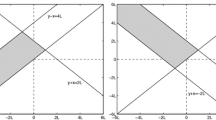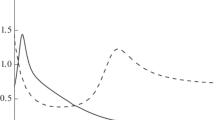Abstract
The problem of numerical solution of a nonlinear Schrödinger equation is considered from the point of view of applications to the compensation of signal distortions in a fiber optic communication line. The problem of constructing fast algorithms for the direct and inverse scattering problems for the Zakharov–Shabat system of equations is studied. An overview of the main methods used currently is given. The time complexity of the algorithms is described together with their applicability to realistic signals.



Similar content being viewed by others
References
M. I. Yousefi and F. R. Kschischang, “Information transmission using the nonlinear Fourier transform. Part I: Mathematical tools,” IEEE Trans. Inform. Theory 60 (7), 4312–4328 (2014).
M. I. Yousefi and F. R. Kschischang, “Information transmission using the nonlinear Fourier transform. Part II: Numerical Methods,” IEEE Trans. Inform. Theory 60 (7), 4329–4345 (2014).
M. I. Yousefi and F. R. Kschischang, “Information transmission using the nonlinear Fourier transform. Part III: Spectrum Modulation,” IEEE Trans. Inform. Theory 60 (7), 4346–4369 (2014).
J. Ginibre and G. Velo, “On a class of nonlinear Schrödinger equations,” J. Funct. Anal. 32, 1–32 (1979).
W. A. Strauss, “Mathematical aspects of classical nonlinear field equations,” in Nonlinear Problems in Theoretical Physics, Lect. Notes in Phys. (Springer, Berlin, 1979), Vol. 98, pp. 123–149.
M. Tsutsumi, “Sobolev spaces and repeadly decreased solutions of some nonlinear dispersive wave equations,” J. Differential Equations 42 (2), 260–281 (1981).
L. D. Faddeev and L. A. Takhtajan, Hamiltonian Methods in the Theory of Solitons (Springer, Berlin, 1987).
T. Cormen, Ch. Leiserson, R. Rivest, and C. Stein, Introduction to Algorithms (Oldenbourg Verlag, München, 2010).
D. Rafique, “Fiber nonlinearity compensation: commercial applications and complexity analysis,” J. Lightwave Technology 34 (2), 544–553 (2016).
G. L. Lamb (Jr.), Elements of Soliton Theory (John Wiley & Sons, New York-Chichester-Brisbane- Toronto, 1980).
V. E. Zakharov and A. B. Shabat, Exact Theory of Two-Dimensional Self-Focusing and One-Dimensional Self-Modulation of Waves (INF, Novosibirsk, 1971) [in Russian].
V. A. Marchenko, “Recovery of the potential energy from the phases of scattered waves,” Dokl. Akad. Nauk SSSR 104 (5), 695–698 (1955).
I. M. Gel’fand and B. M. Levitan, “On the determination of a differential equation from its spectral function,” Izv. Akad. Nauk SSSR Ser. Mat. 15 (4), 309–360 (1951).
S. K. Turitsyn, J. E. Prilepsky, S. T. Le, S. Wahls, L. L. Frumin, M. Kamalian, and S. A. Derevyanko, “Nonlinear Fourier transform for optical data processing and transmission: advances and perspectives,” Optica, No. 4, 307–322 (2017).
V. Vaibhav, “Fast inverse nonlinear Fourier transformation using exponential one-step methods: Darboux transformation,” Phys. Rev. E 96 (6), 063302-1–063302-35 (2017).
W. K. McClary, “Fast seismic inversion,” Geophysics 48 (10), 1371–1372 (1983).
V. Vaibhav, “Nonlinear Fourier transform of time-limited and one-sided signals,” J. Phys. A 51 (42), Art no. 425201 (2018).
S. Wahls and H. V. Poor, “Fast numerical nonlinear Fourier transforms,” IEEE Trans. Inform. Theory 61 (12), 6957–6974 (2015).
S. Chimmalgi, P. J. Prins, and S. Wahls, “Fast nonlinear Fourier transform algorithms using higher order exponential integrators,” IEEE Access 7 (1), 145161–145176 (2019).
M. G. Krein, “On determining the potential of a particle from its \(S\)-function,” Dokl. Akad. Nauk SSSR 105 (4), 433–436 (1955).
O. V. Belai, L. L. Frumin, E. V. Podivilov, and D. A. Shapiro, “Efficient numerical method of the fiber Bragg grating synthesis,” J. Opt. Soc. Amer. B Opt. Phys. 24 (7), 1451–1457 (2007).
V. V. Voevodin and E. E. Tyrtyshnikov, Numerical Processes with Toeplitz Matrices (Nauka, Moscow, 1987) [in Russian].
F. de Hoog, “A New Algorithm for Solving Toeplitz Systems of Equations,” Linear Algebra Appl. 88/89, 123–138 (1987).
G. H. Golub and Ch. F. Van-Loan, Matrix Computations (Johns Hopkins University Press, Baltimore, MD, 2013).
D. A. Bini, L. Gemignani, and V. Y. Pan, “Fast and stable QR eigenvalue algorithms for generalized companion matrices and secular equations,” Numer. Math. 100 (3), 373–408 (2005).
V. Y. Pan, “Solving a polynomial equation: some history and recent progress,” SIAM Rev. 39 (2), 187–220 (1997).
L. M. Delves and J. N. Lyness, “A Numerical Method for Locating the Zeros of an Analytic Function,” Math. Comp. 21 (100), 543–560 (1967).
A. M. Bruckstein, B. C. Levy, and T. Kailath, “Differential methods in inverse scattering,” SIAM J. Appl. Math. 45 (2), 312–335 (1985).
A. M. Bruckstein, I. Koltracht, and T. Kailath, “Inverse scattering with noisy data,” SIAM J. Sci. Statist. Comput. 7 (4), 1331–1349 (1986).
A. M. Bruckstein and T. Kailath, “Inverse scattering for discrete transmission-line models,” SIAM Rev. 29 (3), 359–389 (1987).
J. Skaar, L. Wang, and T. Erdogan, “On the synthesis of fiber Bragg gratings by layer peeling,” IEEE J. Quant. Electron. 37 (2), 165–173 (2001).
L. Poladian, “On the synthesis of fiber Bragg gratings by layer peeling,” IEEE J. Quant. Electron. 37 (2), 165–173 (2001).
L. Poladian, “Simple grating synthesis algorithm,” Optics Lett. 25 (11), 787–789 (2000).
Author information
Authors and Affiliations
Corresponding author
Additional information
Translated from Matematicheskie Zametki, 2022, Vol. 112, pp. 198–217 https://doi.org/10.4213/mzm13561.
Rights and permissions
About this article
Cite this article
Delitsyn, A.L. Fast Algorithms for Solving the Inverse Scattering Problem for the Zakharov–Shabat System of Equations and Their Applications. Math Notes 112, 199–214 (2022). https://doi.org/10.1134/S0001434622070240
Received:
Revised:
Accepted:
Published:
Issue Date:
DOI: https://doi.org/10.1134/S0001434622070240




